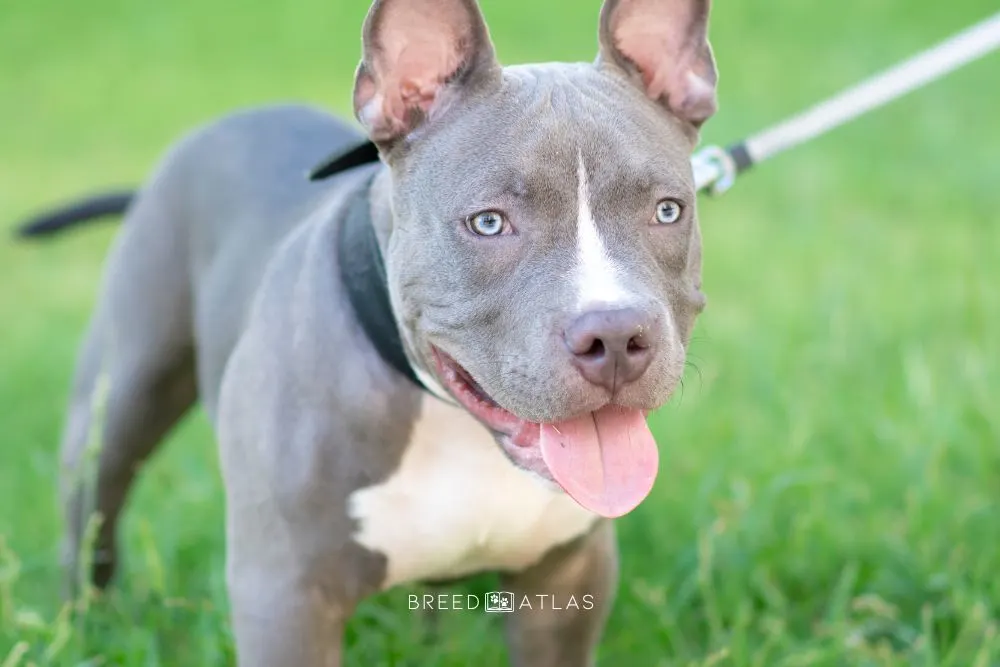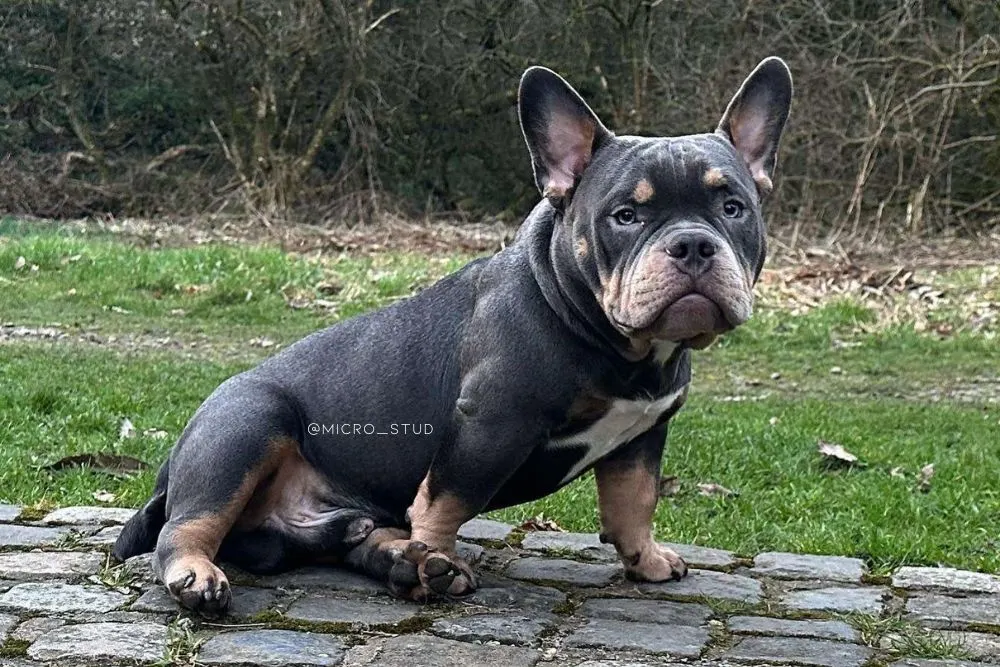Micro Bully vs Pocket Bully – are there any differences? This is a question many dog lovers don’t know the answer to, and it’s easy to see why.
American Bullies are a fairly new dog breed, but they have already gathered lots of fans. Many experts have jumped on the bandwagon and decided to produce new types of pups for potential owners worldwide.
XL Bullies, Exotic Bullies, Micro Bullies… With so many new species of Bullies being created every few decades, it’s hard to keep track!
But what’s the deal with tiny versions of these dogs? Micro Bully vs Pocket Bully: which one holds the title of the smallest Bully type? Are there even any differences, or are both the same breed being sold by the different names?
Let’s find out!
Micro Bully Vs Pocket Bully
| Height | Weight | |
|---|---|---|
| Pocket Bully | 14 – 17 inches | 30 – 50 lbs |
| Micro Bully | 12 – 14 inches | 10 – 49 lbs |
| Coat Length | Lifespan | Accepted by ABKC |
|---|---|---|
| Short | 10 – 14 years | Yes |
| Short to medium | 5 – 8 years | No |
Breed History
While these two pups might seem similar, they are not the same. To fully understand the Micro Bully vs Pocket Bully comparison, you need to go to the beginning first.
The American Bully is a fairly new canine that was developed in the 1980s. These dogs are a type of Pitbull breed, just like the American Staffordshire Terrier, American Pitbull Terrier, Staffordshire Bull Terrier, and the American Bulldog.
They are not recognized by the American Kennel Club (AKC), but their breed standard is set by the American Bully Kennel Club (ABKC).
Now, let’s see when Micro Bullies and Pocket Bullies come into play.
Pocket Bully

As you might’ve guessed from its name, a Pocket Bully is a smaller version of an American Bully. However, this is not a purebred dog.
To achieve Pocket Bully’s small size, breeders have crossbred American Bullies with Patterdale Terriers.
Still, they are one of the four types of Bullies accepted by the ABKC.
Micro Bully

Micro Bullies are designed to be the smallest of all Bully dogs. They are the result of crossbreeding Patterdale Terriers with small Bulldog breeds, such as French Bulldogs or Olde English Bulldogs.
They can also be the result of breeding two Pocket Bully runts of the litter, but this is the rarer case.
As such, many people don’t consider them to be true American Bullies. Even the International Bully Coalition (IBC) considers them a separate breed.
It’s important to keep in mind that most Micro Bullies come from unethical breeding practices. While no American Bully dog, including Pocket Bullies, is recognized by most kennel clubs, things only get worse with even less accepted Micro Bullies.
My advice would always be to avoid buying toy versions of any dog breed altogether, but if you really wish to have this type of Bully, make sure to find a reputable breeder who will know the genetic background and health of all of their dogs.
Physical Features
All Bullies have a fairly similar appearance. They are strong dogs with musculature bodies, a brachycephalic face, and short, upright ears that have been cropped.
This is also one of the most colorful dog breeds out there, and there are numerous American Bully colors for you to choose from.
When it comes to Micro Bullies vs Pocket Bullies, the biggest difference lies in their size.
Pocket Bully
Pocket Bullies look just like standard American Bullies, but they are much smaller in size. In fact, a male will rarely be taller than 17 inches. Females are shorter, and they rarely grow taller than 16 inches in shoulder height.
Males typically weigh 30 – 50 lbs, while females are unlikely to reach 20 lbs.
Pocket Bullies have large heads and big, round eyes. Their legs are a bit shorter compared to their bodies, and they, in general, are more compact.
Micro Bully
Micro Bullies are one of the smallest dogs that look like Pitbulls. They can match some toy dog breeds in height!
Most Micro Bullies won’t grow taller than 14 inches, and they’ll typically weigh around 20 – 40 lbs.
Also, some Micro Bullies might have certain physical characteristics that will resemble Bulldogs more than typical Pitbull breeds.
They will have smaller heads, and their eyes will be almond-shaped. Also, ear cropping isn’t that common in Micro Bullies, and their ears are either upright or left naturally flopped. They’ll have short natural tails that don’t need docking.
Considering all the various colors they come in, it’s easy to see why they are considered some of the cutest Pitbull breeds out there!
Temperament
American Bullies were bred to be friendlier versions of Pitbull dogs. They’re social and playful, and many are even great with kids!
Once again, however, due to different parent breeds, some differences do exist.
Pocket Bully
Pocket Bullies are playful dogs that will love nothing more than to spend their days with their human family members.
While they don’t have too high energy levels, they can still be somewhat hyper when younger. Their overall calm demeanor can be intertwined with active moments, and they require regular exercise.
Micro Bully
Micro Bullies are Bulldog mixes. This means they have that typical Bulldog laziness Pocket Bullies lack.
These dogs can spend whole days laying in their beds, relaxing. Sure, they can have active days, especially in puppyhood, but their energy levels go down as soon as they become adult dogs.
Still, they do need some exercise time, or they’ll become rather bored.
Trainability

When it comes to Micro Bullies and Pocket Bullies, there aren’t that many differences in trainability.
Both dogs love to please their owners, and would greatly benefit from early training and socialization.
These pups respond well to positive reinforcement, so implement lots of treats and pet sessions during training time.
Never yell or punish your small American Bully, or any other dog for that matter! These are sensitive dogs that might shut down if they feel like you’re rejecting them.
Also, they are very intelligent. While this means they are highly trainable, they might also be a bit stubborn, so dedication is the key. Don’t give in to their puppy eyes, and make sure they are on their best behavior.
Pocket Bully
Pocket Bullies might be a bit more stubborn of the two, as they are a bit more independent. However, this mostly comes down to a dog’s individual personality.
Also, they might have issues focusing on your lessons if they haven’t depleted their energy levels.
Micro Bully
Micro Bullies are smart doggies that are very easy to train. They are not as active as Pocket Bullies, so they’ll be more attentive to what you’re teaching them – as long as they aren’t tired and thinking about bedtime.
Exercise Requirements
These pups have somewhat similar requirements when it comes to exercise. They are not the most active dogs, so you won’t have to work with them too much.
In general, long walking sessions should be more than enough to provide them with just enough activity they need.
Don’t let their laziness make you allow them to spend their entire days lying on the couch. These pups are prone to obesity, so they have to stay active.
Still, keep in mind that you shouldn’t go overboard and force them to be more active than needed. Due to their brachycephalic faces, they might have breathing problems if they work out too much. Not to mention how their joints might have problems during walk sessions that last for too long.
By buying your Pocket and Micro Bullies high-quality toys, especially intellectual ones, can help keep their activity levels at bay without having to stress them out with plenty of exercise.
Pocket Bully
Pocket Bullies have a bit more energy than their smaller counterparts. Also, as they are slightly larger, their bones and joints are slightly stronger. This means they can withstand longer walks than Micro Bullies.
Micro Bully
Micro Bullies are tiny dogs with small energy levels. They need even less activity than Pocket Bullies, making them a perfect choice for an owner who doesn’t want to spend hours walking their dog or playing fetch.
Grooming

While Pocket Bullies and Micro Bullies share similar looks, they do have slightly different grooming requirements.
Fortunately, both canines have really easy maintenance, so you won’t have to spend hours a week brushing them, or dealing with plenty of hair fallout.
Next to dealing with a dog’s coat, don’t forget to brush his teeth, clean his ears, and clip his nails. Also, American Bully’s wrinkles might require some additional cleaning to avoid skin problems.
Pocket Bully
Pocket Bullies have a short, smooth coat that has a beautiful shine when clean.
They require little to no brushing, and their shedding amount is minimal. I would recommend getting them a good bristle brush, as these types of tools have proven to be the most successful when it comes to grooming short hair.
Micro Bully
Micro Bullies can have slightly longer coats than Pocket Bullies. Their hair is short to medium in length and can be a bit more coarse.
Thankfully, due to their small size, you are unlikely to find clumps of hair all over your home. Still, make sure to brush them regularly, especially during the shedding season. This is when the hair loss can become moderate.
Health
All types of American Bullies are considered healthy breeds. As they are a fairly new dog breed, there hasn’t been too much inbreeding, so they are somewhat resistant to many health problems.
Some common health issues both Micro Bullies and Pocket Bullies might experience include:
- Demodectic mange, one of the most widespread skin problems in canines. Some of its symptoms include hair loss, skin itchiness, and redness. It’s important to know how to treat this and many other skin conditions in Bullies, as they can spread to other dogs rather quickly.
- Cherry eye, an eye condition that is, essentially, a prolapsed tear gland. It’s especially common in young Bullies.
- Hip dysplasia and elbow dysplasia, health issues that affect the dog’s hip and elbow joints and can be quite painful. Most reputable breeders will conduct OFA screenings to make sure their pups don’t have a genetic predisposition for this health issue.
- Luxating patella, another bone problem that is known to affect all Pitbull-type canines.
- Heart murmurs, a heart disease common in both Pocket Bullies and Micro Bullies, but most of the time don’t require any treatment.
- Dental problems that plague most dogs but are especially common in dogs that are of smaller size. Not only are they dangerous, they can cause an American Bully to smell really bad!
There are several things you can do to make sure your pup is as healthy as possible for a long time, and to ensure his good condition.
First and most importantly, it’s important to avoid unscrupulous breeders who have questionable breeding practices. These people rarely conduct health checks when breeding dogs, and only care about profit.
This means that the dogs they sell are more likely to suffer from various health conditions.
Next, you should give your pooch a healthy, balanced diet and make sure he has just enough training sessions. This will help not just his energy levels, but also his overall health.
Finally, don’t forget about dental care! Keeping your puppy’s teeth clean will not just help his gums, but it can also keep his guts healthy, as it will keep bad bacteria from spreading into the canine’s body.
Pocket Bully
Pocket Bullies are typically prone to all health issues other types of American Bullies have. Still, they might be a bit more prone to certain conditions, such as arrhythmia, obesity, and certain types of cancer.
Micro Bully
While Micro Bullies tend to suffer from the same health issues as Pocket Bullies, there are a few differences. For example, due to their short legs, they are more prone to certain bone and joint disorders, such as luxating patella.
Also, they are more prone to certain conditions typical for brachycephalic dogs, such as respiratory problems and brachycephalic obstructive airway syndrome (BOAS).
Which One Is The Right Dog For You?
After learning all about the Micro Bully vs. Pocket Bully debate, you might be wondering which dog best fits your needs and requirements.
While the biggest differences seem to be in terms of the size of these dogs, this still affects some other aspects of life.
Both of these pups are a great choice for smaller homes and apartments, and they don’t require too much exercise and training.
Still, if you want a dog that will shed as little as possible and have patience for his sudden outbursts of energy, a Pocket Bully might be a better choice.
On top of that, if you’d like the smallest dog possible that is fairly calm and doesn’t mind a little bit of shedding, Micro Bullies are the dog for you.
Another thing to keep in mind is that Pocket Bullies are accepted by the ABKC, while Micro Bullies aren’t.
Not only does this mean you won’t be able to participate in dog shows with your Micro Bully, but this also means there are more irresponsible breeders that might sell you an unhealthy pup.
This also means that these micro pups might be slightly more prone to health problems.
Bottom Line
There you have it – Micro Bully vs. Pocket Bully debate explained.
In the end, it doesn’t matter which type of dog is better. Both of these adorable doggies make amazing pets, and they’re some of the most loveable canines out there.
Just remember to take great care of them, as these tiny pups are more sensitive than their larger counterparts.
Also, while I agree it can be challenging to resist their cute faces, early socialization and training are the key to preventing behavioral issues.
I hope you have learned something new and that you decide to take one of these cutie-pies for your new family companion

Vanja’s passion for writing started at an early age, which is why she pursued Journalism as her college degree. She can research any topic and find all the information before you bat an eye, which is a great thing for her job but a terrible one for her husband.
Even as a young child, she fell in love with everything fluffy – but dogs have a special place in her heart due to her childhood companion, a Corgie named Archie.
Motivated by her experiences and driven by a desire to give back to her four-legged companions, she spends her free time volunteering at a local dog shelter.
